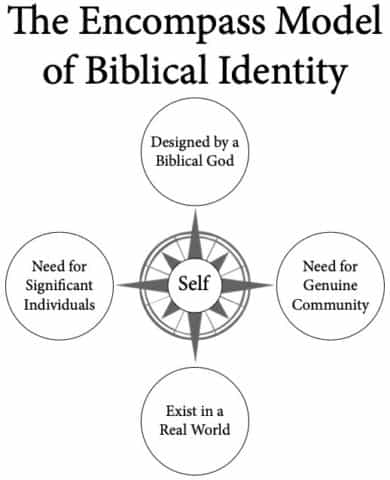A Biblical Identity Model

Photo by Annie Spratt on Unsplash
A biblical identity must, by definition, reflect what the Bible says (or assumes) to be true about people. (The Bible is not always overt in its teachings. When the Bible assumes something to be true, then we can be certain that is the case.) Creating a model of biblical identity provides educators, ministers, and publishers with a target to aim for as we think about helping children develop healthy identities. If we build on the factors that impact identity (see other articles referenced below), then we can create a practical model that describes the various components of a biblical identity and their relationship to the self.
The Encompass Model of Biblical Identity
 The accompanying graphic provides a very general, but comprehensive model for a workable framework within which we can identify important topics related to biblical identity and then create educational content around those topics.
The accompanying graphic provides a very general, but comprehensive model for a workable framework within which we can identify important topics related to biblical identity and then create educational content around those topics.
Note how the vertical axis (God and the real world) defines reality. Whatever the self may think is true or valid, reality always trumps a faulty worldview. God’s design is what it is. God created human beings to be human beings, not cars, dandelions, or rodents. Similarly, the real world will insist on submission to reality, no matter what the individual has come to believe. Perceived identity cannot overcome actual reality. A disconnect between perceived identity and real identity will create a variety of problems for the individual.
The horizontal axis (need for individuals and community) reveals that humans have genuine relational needs that shape their identities. The quality of our lives depends, in part, on our success in meeting this need. We do this by attaching to significant individuals and genuine community in healthy ways. A healthy identity will indicate that attachments have been made that reflect and affirm biblical truth.
The Self
As noted earlier, the Self acts as the engaged “gate keeper,” evaluating incoming data and determining whether any particular claim should be allowed into the self’s worldview (internal set of convictions). In very young children, the Self is acting as a moderator more than an influencer. That changes, however, as the child develops higher levels of reasoning, at which time he or she will begin calling on former memories and experiences to inform the evaluation of new data.
Designed by a Biblical God
Humans were created by God and, consequently, are designed in His image with certain unchangeable “design characteristics.” This element of the model will foster consideration of topics like what it means to be human, what does it mean to be male or female, and what does it mean to have inherent significance? This list will grow as we wrestle with ways to help children develop a biblical identity.
Exist in a Real World
As babies engage with the surrounding environment, they seem to learn quickly that reality exists. They also learn about the visible and invisible nature of reality, the goodness of creation, and the brokenness of creation. Churches and families need to ground children in an appropriate understanding of reality. This part of the model creates an opportunity for educators to affirm and define reality, and give children the tools to do so.
Need for Genuine Community
There are those, of course, who prefer to isolate themselves from genuine community, but separation is not a biblical option. People, especially children, need community and the relationships it fosters. But this element of the model also points to issues like love, protection and security, economic development, and justice. Some of the more complex issues associated with community will, clearly, come later, but this aspect of the model underscores our responsibility to help children identify appropriately with one or more communities, including the local church.
Need for Significant Individuals
We learn early the need for and importance of having significant individuals in our lives. Apart from the mediating role of the Self, it is the significant individuals in our lives that typically have the greatest impact on our early identity development. It is in these relationships (typically in the family) that children learn some of the most important lessons they will EVER learn. Consequently, this part of the model opens the door for the Christian educator to address issues such as love, relational significance, the priority of family, the need for boundaries, the flow of time and the role of history and personal story, and the need to develop discipline (the ability to say “no”).
This article is one of a series related to identity.
Find Helping People Develop a Biblical Identity here.
Find We Are More Than We Think here.
Find Shaping Identity in the Local Church here.
Find Identity and the God of the Bible here.
Find Identity, Relationships, and Distinction here.
Find Attachments and Identity here.
Find The Power of the Individual in Shaping Identity here.
Find The Power of the Community in Shaping Identity here.
Find The Surrounding Environment and Identity here.
Rick Edwards
Author, Speaker, Bible Teacher
See a list of other articles by Rick Edwards.



